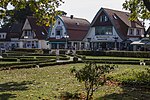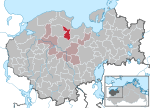Schloss Bothmer
Baroque palaces in GermanyBuildings and structures completed in the 18th centuryCastles in Mecklenburg-Western PomeraniaNordwestmecklenburg

Schloss Bothmer is a Baroque palatial manor house ensemble in northern Germany. It was built for Count Hans Caspar von Bothmer to designs by architect Johann Friedrich Künnecke in 1726–32. It remained the property of the Bothmer family until 1945. It is today owned by the State of Mecklenburg-Vorpommern and, following a renovation in 2009–15, open to the public. It is the largest Baroque-era country house ensemble in Mecklenburg-Vorpommern.
Excerpt from the Wikipedia article Schloss Bothmer (License: CC BY-SA 3.0, Authors, Images).Schloss Bothmer
Am Park, Klützer Winkel
Geographical coordinates (GPS) Address Website External links Nearby Places Show on map
Geographical coordinates (GPS)
| Latitude | Longitude |
|---|---|
| N 53.959444 ° | E 11.159167 ° |
Address
Schloss Bothmer
Am Park
23948 Klützer Winkel
Mecklenburg-Vorpommern, Germany
Open on Google Maps







